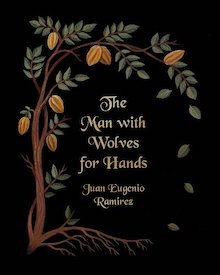
In his debut novel, The Man with Wolves for Hands (Southeast Missouri State Univ Press), Juan Eugenio Ramirez creates a layer of stories within the narrative where inanimate objects become autonomous and the mundane becomes significant. Demonstrating a truly original imagination, a vivid backdrop is developed for a man living with wolf’s heads where his hands should be, creating believable scenarios in a tone of playful absurdity that compels the reader to re-see and reimagine their ideas of what’s normal.
Annie McClanahan, author of Dead Pledges: Debt, Crisis, and 21st Century Culture, writes:
The Man with Wolves for Hands blends origin myths and apocalyptic revelations, feral fairy-tale and sharp-toothed satire, whimsical daydreams and vivid nightmares. Weird fiction just got wilder—and more beautiful.
Rumer Henry spoke with Juan Eugenio Ramirez about the technique of making the familiar strange, developing the meta-fictional device of stories within stories, and how this novel has already begun to influence his future work.
+
Rumer Henry: The Man with Wolves for Hands is an allegorical masterpiece of interconnected vignettes, in which the character possesses wolves where his hands should be. I have to ask: are the wolves for hands an allegory for a life lived with a physical disability? Or is that too specific? Is the metaphor meant to be purposely vague to include any number of potential problems?

Juan Eugenio Ramirez: As far as allegory goes, as much of a fan as I am of the technique, it wasn’t the initial idea. I did not set out to write an allegory, I can’t, however, deny the influence allegory has had in the shaping of my imagination—especially when one grows up with a healthy dose of fairytales, fables, and myths as childhood reading material. Honestly, reading Italo Calvino’s Six Memos for the Next Millennium, a series of lectures on writing, sparked the impetus for the story. In it Calvino mentions beginning a story from just an image, and the image of a man with wolf heads where hands should be had been an image I’d been carrying around in my head for some time. I began placing this image in action: attempting to complete tasks, living in the world, attempting to communicate. I filled the image with the emotional and the intellectual. Through this process, this deliberate act of making the familiar strange, this warping, shaping, and reshaping, I invited the metaphorical to inhabit the image. This wasn’t planned, but once I noticed the potential for metaphor within the story, I started to craft the thing with more intentionality. Crafting is a deliberate process, but it did take some time to get there.
RH: The wolves seem to have some semblance of autonomy, in the sense that they act outside of the man’s wishes at times; and they have desires that compel them to action. What were you hoping to add to the story by giving the wolves this freedom?
JER: The wolves are characters in the narrative. They inhabit the world of the story, no differently than the other characters. They are alarming, strange, beautiful. I hope this sort of deliberate choice in their crafting helps reveal something deeply personal in the reading experience. I crafted the image to be strange, not knowing where it would lead me at first. In reading, confronted with such strangeness shocks the body, like jumping into freezing water. It resets the wires, making us see things differently. It invites the reader to contribute to the story-telling process, encourages them to partake in meaning-making, creating, thus, a whole new narrative layer.
RH: You paint the wolves as dog-like. The man even takes them for walks in the park and out to “romp in the yard.” Why did you decide to give these normally wild and aggressive predators a more docile personality?
JER: The wolves are strange, but they are also familiar. This juxtaposition allows The Man with Wolves for Hands, as a character, to be a little more like us, a little more believable. I did not want to write a monster story nor a horror story. The wolves as wolves felt a bit too kitschy. I mean, it’s already weird enough. I rarely consume the horror genre, maybe a movie here and there, but it’s a genre I don’t feel comfortable writing. Dog-like wolves, as strange as this may seem, in my thinking, help ground the already surreal image of a man with wolf heads where hands should be.
RH: Many of the stories in this collection seem to be about everyday activities such as cooking or building a bookshelf. In fact, there are small details (like the instructions on how to make the perfect risotto) that consistently splash “color” into the story. How, as a writer, do you work to make these seemingly mundane moments so significant?
JER: I mentioned narrative layer in a previous response. These steps provide just that: another layer of narrative. Bob Lyle’s epigraphs at the beginning of the chapters achieve the same thing, and Dr. Fausto’s raconteur-ish anecdotes. This deliberate layering process is a conscious crafting choice. I like stories that exist within stories. I’m thinking Shakespeare’s plays within plays, like in Hamlet and A Midsummer Night’s Dream or even the many allusions and references in Joyce’s Ulysses. Crafting with such layering—I hope—enriches the narrative’s psychic landscape.
RH: This is your debut book, congratulations! That is a huge accomplishment. What was your favorite aspect of the publishing process?
JER: The best part of the publishing process was getting to work with my publisher James
Brubaker. He gave me thoughtful revision advice and always asked questions when it came to those revisions. I could tell he wanted this book to be wholly mine, with my voice, and my choices. He let me defend those choices and keep many of them. There was discourse between the two of us. He saw things I didn’t see. We suffer fatigue when we look at a manuscript long enough. We need a fresh set of eyes on it. James performed his job with absolute professionalism and deep care.
RH: What is next for Juan Eugenio Ramirez?
JER: I am currently working on the next project, a novel where many of the techniques from The Man with Wolves for Hands—narrative layering, surrealism, tautology, allusion, the psychic charging of images—take on a more prominent role in crafting. The Man with Wolves for Hands was an exercise. Reading: reading is the single most important aspect of my artform. There is no writing without voracious reading. For this new novel, I am reading or have read books by Herodotus, Aeschylus, Apuleius, Bede, Marie de France, Christine de Pizan, St. Teresa of Avila, St. Catherine of Genoa, Angela Carter, Kathryn Davis, Mercè Rodoreda, Laila Lalami, Zora Neale Hurston, Henri Bosco, Gaston Bachelard, Giorgio Agamben…and many others. I read and close read in the marginalia. I learn. I try things out: adopt them or discard them. Much of the reading, for this new book, informs the shaping of characters. For example, I’m reading a ton of medieval and Renaissance Christian mysticism because I have a character whose personality echoes the teachings of Christian Mystics. As a high school teacher at an independent, progressive high school, I have full access to JSTOR through our public library, so I’ve also been reading scholarly articles on clowns as subversive figures in history and literature.
+++
Though born in Washington state, Juan Eugenio Ramirez spent most of his formative years in Florida. Having taught both middle school and high school these past fifteen years, Juan holds an MFA in poetry from Sarah Lawrence College and a BA from Florida State University. His work has appeared in The Carolina Quarterly, Armchair/Shotgun, and Madcap Review. He currently teaches high school English at St. Francis School, an independent, progressive education school in Louisville, Kentucky.
+
Rumer Henry studies creative writing at the University of Arkansas at Little Rock and recently served as an editorial intern with the independent literary press, Braddock Avenue Books.